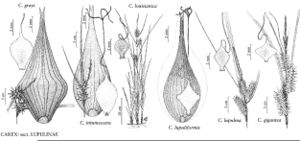Carex intumescens
Trans. Linn. Soc. London 7: 97, plate 9, fig. 3. 1804.
Plants cespitose or not, short-rhizomatous. Culms solitary or not, erect, (15–)30–80(–140) cm. Leaves 6–12; basal sheaths purplish red; sheath of distal leaf 0–1(–2.5) cm; ligules rounded, 1–8 mm; blades 8–27 cm × 3.5–8 mm. Inflorescences 2–15 cm; peduncles of proximal pistillate spikes 0.3–1.5 cm, basal 2 peduncles 0.2–2.1 cm apart; of terminal spike 0.5–4 cm; bracts leafy, sheathless, blades 6–21 × 2–6 mm. Spikes: proximal pistillate spikes 1–4, often closely aggregated and difficult to distinguish, 1–12-flowered, ovoid to obovoid, 1–2.7 × 1–2.8 cm; terminal staminate spike 1, 1–5 cm × 1–3 mm. Pistillate scales 1–3-veined, lanceolate-ovate to ovate, 4–9.5 × 2–3.8 mm, apex acute to awned, awns rough, to 6.5 mm. Anthers 3, 2–4 mm. Perigynia ascending to spreading or the basalmost reflexed, strongly 13–23-veined, lanceoloid to ovoid, 10–16.5 × 2.5–6.5 mm, with satiny luster, glabrous; beak poorly defined, 2–4.2 mm. Achenes sessile, ellipsoid to obovoid, flat to convex faces, angles not thickened, 3.5–5.7 × (2.2–)2.5–3.9 mm; style same texture as achene.
Phenology: Fruiting late spring–early summer.
Habitat: Dry-mesic to wet coniferous, mixed, and deciduous forests, forest openings, thickets, wet meadows, ditches
Elevation: 0–2000 m
Distribution

Man., N.B., Nfld. and Labr., N.S., Ont., P.E.I., Que., Ala., Ark., Conn., Del., D.C., Fla., Ga., Ill., Ind., Iowa, Ky., La., Maine, Md., Mass., Mich., Minn., Miss., Mo., N.H., N.J., N.Y., N.C., Ohio, Okla., Pa., R.I., S.C., S.Dak., Tenn., Tex., Vt., Va., W.Va., Wis.
Discussion
Plants from the south of the species range and from lower elevations northward are usually more robust and have more inflated, ovoid perigynia than northern or high-elevation plants. The latter are sometimes distinguished as Carex intumescens var. fernaldii L. H. Bailey.
Selected References
None.
